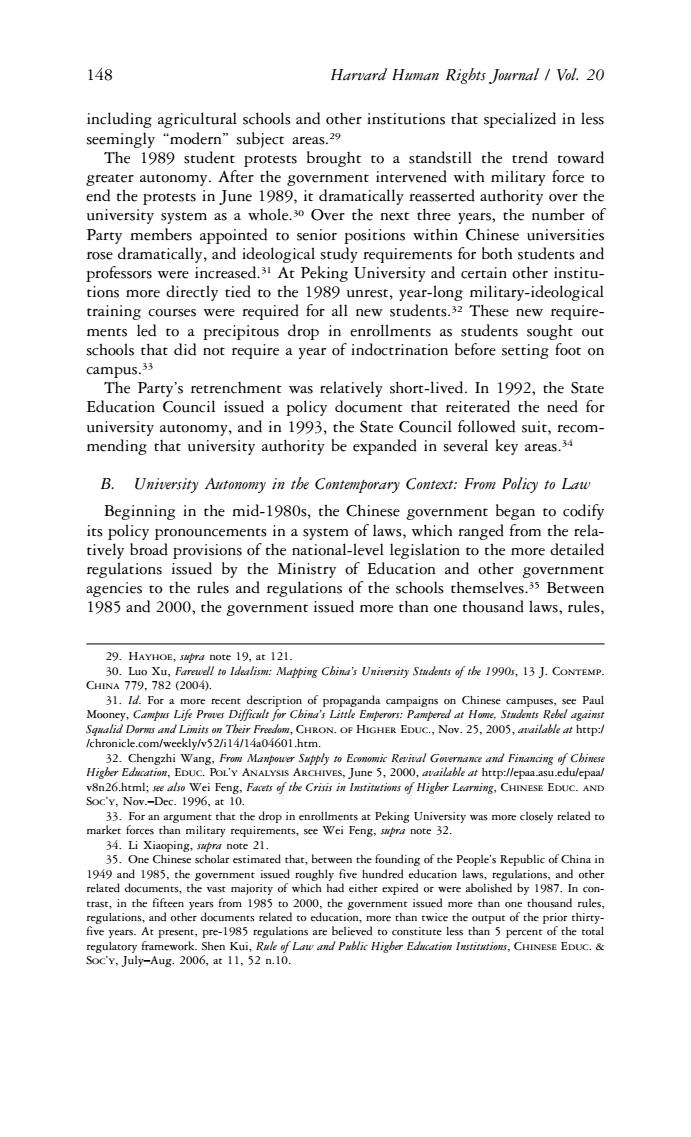正在加载图片...

148 Harvard Human Rights Journal Vol.20 including agricultural schools and other institutions that specialized in less seemingly“modern”subject areas.29 The 1989 student protests brought to a standstill the trend toward greater autonomy.After the government intervened with military force to end the protests in June 1989,it dramatically reasserted authority over the university system as a whole.30 Over the next three years,the number of Party members appointed to senior positions within Chinese universities rose dramatically,and ideological study requirements for both students and professors were increased.31 At Peking University and certain other institu- tions more directly tied to the 1989 unrest,year-long military-ideological training courses were required for all new students.32 These new require- ments led to a precipitous drop in enrollments as students sought out schools that did not require a year of indoctrination before setting foot on campus.33 The Party's retrenchment was relatively short-lived.In 1992,the State Education Council issued a policy document that reiterated the need for university autonomy,and in 1993,the State Council followed suit,recom- mending that university authority be expanded in several key areas.34 B.University Autonomy in the Contemporary Context:From Policy to Law Beginning in the mid-1980s,the Chinese government began to codify its policy pronouncements in a system of laws,which ranged from the rela- tively broad provisions of the national-level legislation to the more detailed regulations issued by the Ministry of Education and other government agencies to the rules and regulations of the schools themselves.35 Between 1985 and 2000,the government issued more than one thousand laws,rules, 29.HAYHOE,supra note 19,at 121 30.Luo Xu,Farewell to Idealism:Mapping China's University Students of the 1990s,13 J.CONTEMP. CHNA779,782(2004). 31.Id.For a more recent description of propaganda campaigns on Chinese campuses,see Paul Mooney,Campu Life Prover Difficult for China's Little Emperors:Pampered at Home,Students Rebel against Squalid Dorms and Limits on Their Freedom,CHRON.OF HIGHER EDUC.,Nov.25,2005,available at http:/ /chronicle.com/weekly/v52/i14/14a04601.htm. 32.Chengzhi Wang,From Manpouer Supply to Economic Revival Governance and Financing of Chinese Higber Education,EDUC.PoL'Y ANALYSIS ARCHIVES,June 5,2000,available at http://epaa.asu.cdu/epaal v8n26.html;se also Wei Feng,Facets of the Crisis in Institutions of Higher Learning,CHINESE EDUC.AND SoC'Y,Nov.-Dec.1996,at 10. 33.For an argument that the drop in enrollments at Peking University was more closely related to market forces than military requirements,see Wei Feng,swpra note 32. 34.Li Xiaoping,supra note 21. 35.One Chinese scholar estimated that,between the founding of the People's Republic of China in 1949 and 1985,the government issued roughly five hundred education laws,regulations,and other related documents,the vast majority of which had either expired or were abolished by 1987.In con- trast,in the fifteen years from 1985 to 2000,the government issued more than one thousand rules, regulations,and other documents related to education,more than twice the output of the prior thirty- five years.At present,pre-1985 regulations are believed to constitute less than 5 percent of the total regulatory framework.Shen Kui,Rule of Law and Public Higher Edmcation Institutions,CHINESE EDUC. Soc'Y,July-Aug.2006,at 11,52 n.10.\\server05\productn\H\HLH\20\HLH2001.txt unknown Seq: 8 12-JUN-07 16:27 148 Harvard Human Rights Journal / Vol. 20 including agricultural schools and other institutions that specialized in less seemingly “modern” subject areas.29 The 1989 student protests brought to a standstill the trend toward greater autonomy. After the government intervened with military force to end the protests in June 1989, it dramatically reasserted authority over the university system as a whole.30 Over the next three years, the number of Party members appointed to senior positions within Chinese universities rose dramatically, and ideological study requirements for both students and professors were increased.31 At Peking University and certain other institutions more directly tied to the 1989 unrest, year-long military-ideological training courses were required for all new students.32 These new requirements led to a precipitous drop in enrollments as students sought out schools that did not require a year of indoctrination before setting foot on campus.33 The Party’s retrenchment was relatively short-lived. In 1992, the State Education Council issued a policy document that reiterated the need for university autonomy, and in 1993, the State Council followed suit, recommending that university authority be expanded in several key areas.34 B. University Autonomy in the Contemporary Context: From Policy to Law Beginning in the mid-1980s, the Chinese government began to codify its policy pronouncements in a system of laws, which ranged from the relatively broad provisions of the national-level legislation to the more detailed regulations issued by the Ministry of Education and other government agencies to the rules and regulations of the schools themselves.35 Between 1985 and 2000, the government issued more than one thousand laws, rules, 29. HAYHOE, supra note 19, at 121. R 30. Luo Xu, Farewell to Idealism: Mapping China’s University Students of the 1990s, 13 J. CONTEMP. CHINA 779, 782 (2004). 31. Id. For a more recent description of propaganda campaigns on Chinese campuses, see Paul Mooney, Campus Life Proves Difficult for China’s Little Emperors: Pampered at Home, Students Rebel against Squalid Dorms and Limits on Their Freedom, CHRON. OF HIGHER EDUC., Nov. 25, 2005, available at http:/ /chronicle.com/weekly/v52/i14/14a04601.htm. 32. Chengzhi Wang, From Manpower Supply to Economic Revival Governance and Financing of Chinese Higher Education, EDUC. POL’Y ANALYSIS ARCHIVES, June 5, 2000, available at http://epaa.asu.edu/epaa/ v8n26.html; see also Wei Feng, Facets of the Crisis in Institutions of Higher Learning, CHINESE EDUC. AND SOC’Y, Nov.–Dec. 1996, at 10. 33. For an argument that the drop in enrollments at Peking University was more closely related to market forces than military requirements, see Wei Feng, supra note 32. R 34. Li Xiaoping, supra note 21. R 35. One Chinese scholar estimated that, between the founding of the People’s Republic of China in 1949 and 1985, the government issued roughly five hundred education laws, regulations, and other related documents, the vast majority of which had either expired or were abolished by 1987. In contrast, in the fifteen years from 1985 to 2000, the government issued more than one thousand rules, regulations, and other documents related to education, more than twice the output of the prior thirtyfive years. At present, pre-1985 regulations are believed to constitute less than 5 percent of the total regulatory framework. Shen Kui, Rule of Law and Public Higher Education Institutions, CHINESE EDUC. & SOC’Y, July–Aug. 2006, at 11, 52 n.10